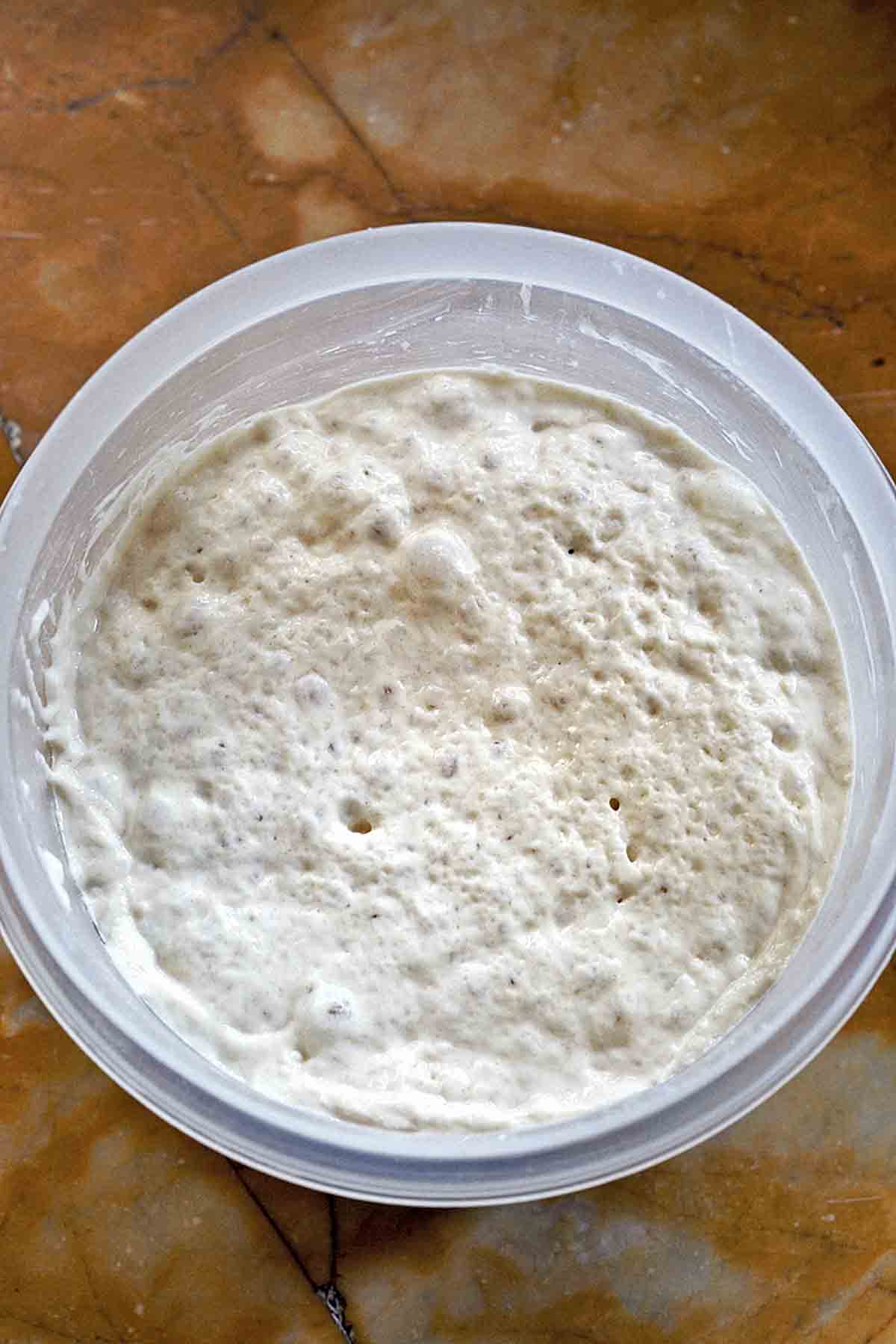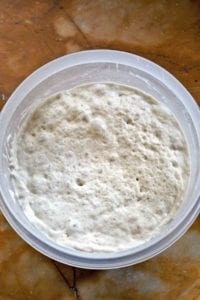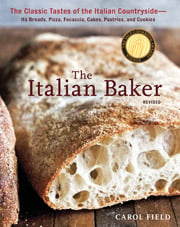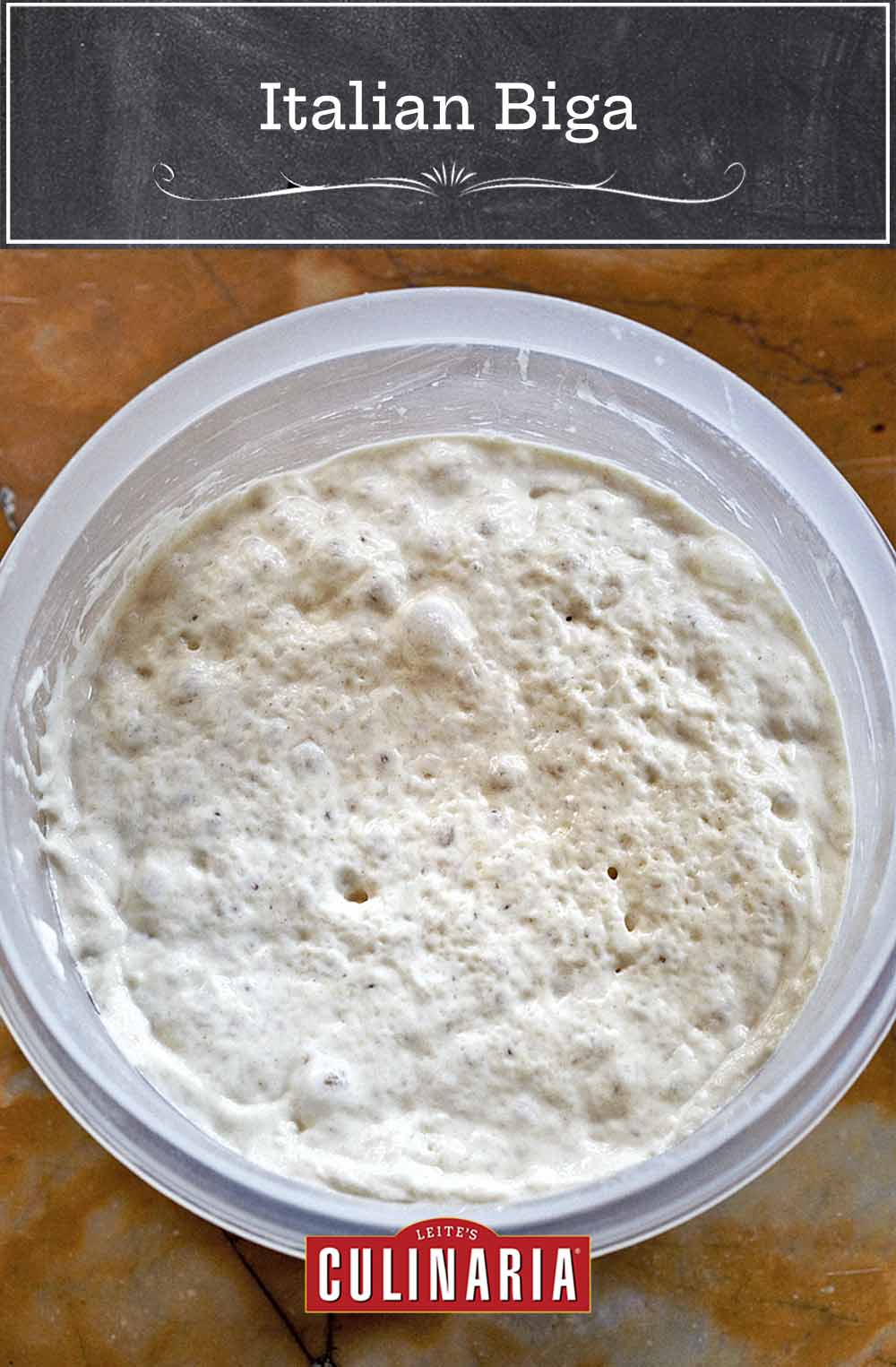
Many of the recipes for classic regional breads, such as this ciabatta recipe, begin with a starter dough made from small amounts of flour, water, and yeast allowed an initial fermentation. The starter, known as biga in Italy, or bighino when in small amounts, not only gives strength to what in Italy are weak flours, it also produces a secondary fermentation from which come the wonderful aroma, natural flavor, and special porosity of the final loaves and wheels of bread.
The important point about a biga is that the breads made with it develop a wonderful taste because their risings are long and bring out the flavor of the grain. Another benefit is that the loaves remain fresher and taste sweeter than those made with large amounts of commercial yeast.
In Italy, bakers use dough from the previous day’s baking to start a new dough. I keep some starter on hand at all times; by having it around, I can decide to make pane pugliese or ciabatta in the morning and have it for dinner that night. Because the first biga must come from somewhere, though, you may make it following the instructions below. It’s remarkable. It freezes very well and needs only about 3 hours at room temperature until it is bubbly and active again, or it can be refrigerated for up to 5 days.–Carol Field
LC Obliged to Biga Note
Behind each and every memorable bite of proper Italian bread we’ve daintily nibbled, hungrily inhaled, or otherwise somehow consumed, we have a biga to thank. So we’re feeling much obliged to Carol Field for this recipe. Nonna not included.

Italian Biga
Ingredients
- 1/4 teaspoon active dry yeast
- 1/4 cup warm water, 100°F to 110°F (38°C to 43°C)
- 3/4 cup plus 4 teaspoons bottled spring water, at room temperature (You can use tap water in a pinch.)
- 2 1/3 cups unbleached all-purpose flour
- vegetable oil, for the bowl
Instructions
- Stir the 1/4 teaspoon active dry yeast into the 1/4 cup warm water and let stand until creamy, about 10 minutes.
- Stir the 3/4 cup plus 4 teaspoons bottled spring water into the creamy yeast mixture, and then stir in the 2 1/3 cups unbleached all-purpose flour, 1 cup at a time. ☞ If mixing by hand, stir with a wooden spoon for 3 to 4 minutes. ☞ If mixing with a stand mixer, beat with the paddle at the lowest speed for 2 minutes. If mixing with a food processor, mix just until a sticky dough forms.
- Transfer the biga to a bowl lightly coated with vegetable oil, cover with plastic wrap, and let rise at cool room temperature for 6 to 24 hours, until the starter is triple its original volume but is still wet and sticky. (The bakers I admire most advise 10 to 11 hours for the first rise, but others are very happy with the 24 hours it takes for dough to truly become yesterday’s dough, and if you like sour bread, allow your biga to rest for 24 to 48 hours or even 72 hours.)
- Cover and refrigerate or freeze the biga until ready to use. (If refrigerating the biga, use within 5 days. If freezing the biga, let it rest at room temperature for about 3 hours until it is bubbly and active again.) When needed, scoop out the desired amount of biga for your recipe and proceed. I strongly recommend weighing the biga rather than measuring it by volume since it expands at room temperature. If measuring by volume, measure chilled biga; if measuring by weight, the biga may be chilled or at room temperature.

Nutrition
Nutrition information is automatically calculated, so should only be used as an approximation.
Recipe Testers’ Reviews
This is a perfectly suitable starting point for most any bread which uses a starter. I bake bread several times a week and it’s nice to have this handy. Sometimes I add this to a bread dough which doesn’t call for a starter just for the added flavor.












I made biga for the first time ever ( stated it Thursday night). I used this recipe and finally on Saturday morning made my first ever ciabatta. What can I say?????
Absolutely brilliant!!! 10 times better than I expected them to come out and to be honest they were near on perfect (considering I don’t have baking stones or parchment paper, had to make do with tin foil and a metal baking tray ?)
I am now making another biga to use for pizza dough. When you read the recipe it does seem very long and time-consuming but in reality, you probably only spend about 10 minutes in total actually doing something (in my case it was constantly referring back to weights and in which order to do stuff ?) Make the biga well ahead of time so you don’t feel like you are ‘waiting’ all day or night.
Thanks for this biga recipe and idea, I’m actually buzzing ????
And here’s the other picture! ?
Stunning, Russ! This is incredibly impressive, especially for your first ciabatta! I am eyeing this loaf right now.
Thanks for that compliment my head is now bugger than the bubbles in the bread ?
I’ve got a biga on the go now and I’m considering using it tomorrow for pizza dough?
Hah! You don’t need it, but you have my approval for the pizza dough. It’s going to be fantastic. I wish we had a recipe on my site for pizza dough made with Biga but I don’t. Shouldn’t let that stop you, though.
Do I need to make a new biga every time I’m about to run out or can I feed it? Thanks!!
Russ, thanks for sharing all of this. And congrats! It’s a gorgeous loaf, and I love how you MacGyvered a baking stone. And yes, so true; I include a lot of information to try to make the process easier in the long run, though it can look somewhat intimidating. But it’s soooooo wicked easy. You’re so very welcome.
I don’t have a lot of bread baking experience, and have never worked with Biga before. I made this for the first time, with the plan to use it for ciabatta. I let it it rise for about 36 hours. It developed a hard, dry crust on the top. I hoped that would dissolve when I started to mix the dough, but that did not happen. I ended up having to pick the hard pieces out with my fingers. I don’t know yet what this will do the end product, as it probably threw the proportions way off. Just wanted to mention it as a warning to other novice bread bakers.
Thanks so much, Claire. Greatly appreciated. I’d like to try to troubleshoot. Did you happen to cover the bowl of biga with plastic wrap? Other readers have mentioned that if they covered the bowl with a towel it formed that same crust, but when they covered it tightly with plastic wrap they had no issue.
Hi Renee, thanks for asking. I am past the trouble shooting phase at this point, but thought a heads-up might help others to avoid my mistake. I did not use plastic wrap. I used cloth, which was probably the cause A more experienced baker may have known better, but my husband has a lot of baking experience and he did not anticipate a problem either.
Claire, thanks for letting me know. Yeah, I suspect that was it, as I’ve experienced that myself with other bread recipes. I always appreciate readers helping us troubleshoot recipes to make a smoother experience for others.
I have followed the exact measurements for big but the big mixture is fairly dry after mixing it (like a ball of dough) it is not liquidy. Is this normal. I have covered it and am letting rise. Is this normal?
Lois, it should be dough-like, but sticky.
it was sticky…ish.. I formed it into a ball and put it in an oiled bowl to rise. Hope this works.
Fingers crossed, Lois.